I have begun building a 7 drawer dresser for a client and as always it starts out with a drawing. Sketchup is a wonderful tool that I have learned to use over the years. I especially like it because I can create the furniture in a three-dimensional drawing that the customer can relate to a lot easier. I can also personally add as much detail to the drawing as I want, essentially drawing in every single joint and basically building the piece virtually before I ever cut a stick of wood.
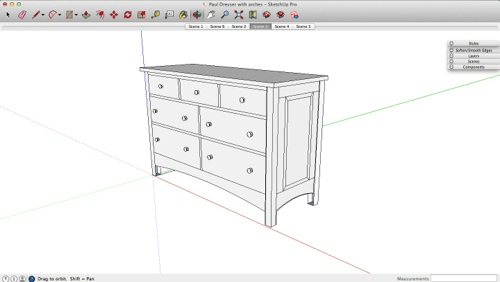
Dresser Drawing in Sketchup
I chose not to draw all the detail on the internal joinery on this piece because I have an idea in my head of how it will go together (this is not the first seven drawer dresser I have built!). What I did spend a fair amount of time doing is creating a spread sheet with a cut list of all the components. This really helps me think through the process and break down each constituent part prior to ever cutting wood. Although it may take quite a while to do this, it really pays off in the long run. I may change things too but at least I have thought through the process and I have an idea on what the dimensions should be. Of course I don’t want to cut all my drawer parts to exact size until I have the case together but at least I have an idea of what the size of the drawer parts are going to be so when I am selecting my wood I can choose which ones will be the drawer parts and which ones will be the top, etc.
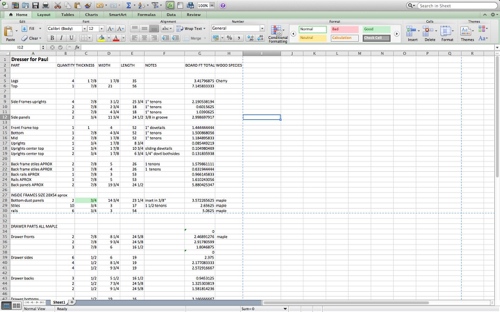
Dresser Cutlist in Excel
I started by looking through the “Trailer load of wood” and selecting the pieces that I thought would work best for each application. For example, the side panels are just under 12″ wide, so I picked out a couple clear 12″ boards for that. I was able to find a perfectly clear board that I was able to get the top out of with only one glue up!
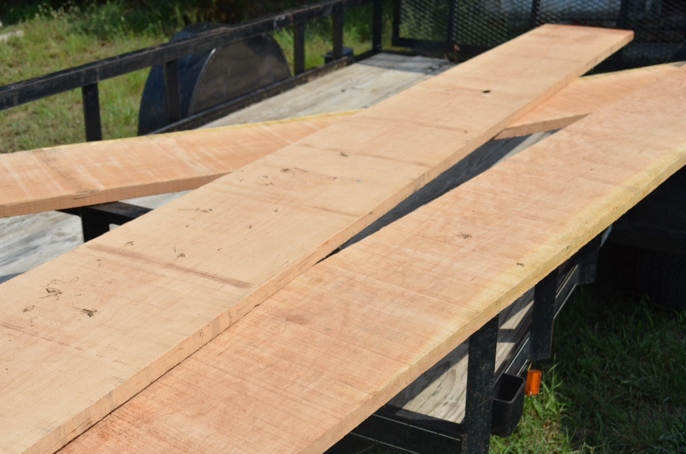
Wide Cherry Boards
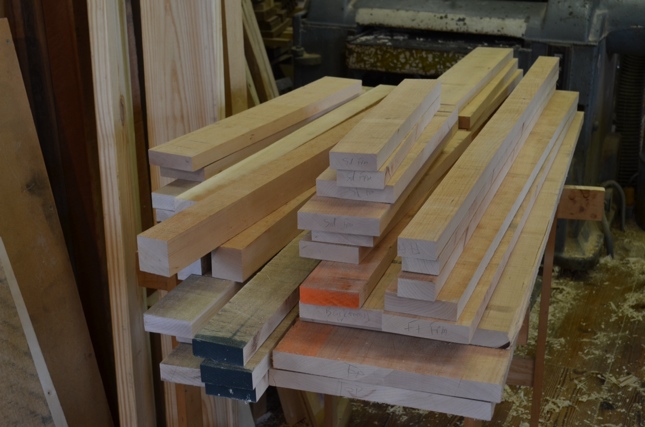
Stack of Wood Ready for Jointing
I start by crosscutting all the stock to about 1 to 2 inches oversize, then I face joint them. This is the time I am very thankful for my 12″ Yates American Jointer, with an 8 foot bed! That thing is so nice.
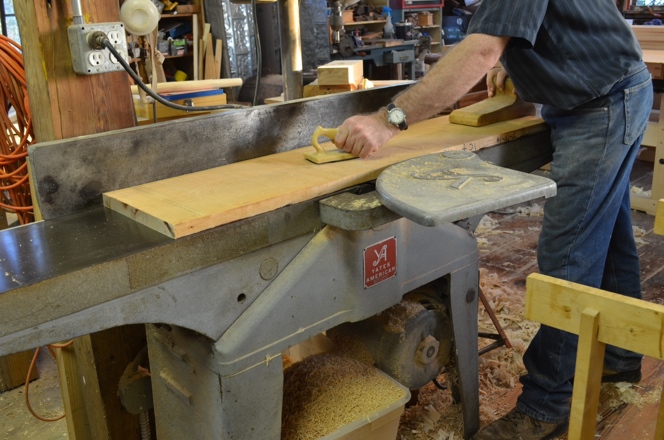
Face Jointing on my 12″ Jointer!
Then I run them through my 24″ Newman planer. I picked up this beast at an auction years ago and it is an amazing piece of equipment. It was built for the US Air Force in 1946 and it is literally built like a tank–or maybe a bomber!

24″ Planer, this thing is sweet!
Again very thankful for this equipment, making a lot of work a little easier.
Just a side note; I am building this piece in my home shop. Our school shop is much bigger and probably a little–no, I meant to say, a lot–cleaner than my shop.
After all the stock is jointed and planed, I start edge jointing and ripping the stock on the table saw. Then I will start the joinery for the side panels and the legs. I am starting with the outside case, so I will be working on the outside frame and panels first.
More on the joinery in the next post!
Frank Strazza
I’ll be interested to learn how you do your drawer dividers since your sides are frame and panel which doesn’t allow the cross grain divider piece to be placed in a groove. Or does it?
Also, what do you do for the back? Ship lap or a frame and panel?
I suppose I can be patient and see for myself in your follow on posts.
Very good questions Mark. The back is frame and panel construction and the dividers for the drawers are going to be tapered sliding dovetails. You will see a lot more of the construction in future posts, so stay tuned!
Thanks for the answers but I made a mistake. I should have said drawer runners instead of dividers. So my first question should have dealt with the runners that are attached and are cross-grained to the sides.
Ah, even better question! The “runners” are actually mortise and tenon frames that I will inset in small dados both in the side panels as well as the legs. The frames eliminate any wood movement. Hopefully you will see some of this in the next few posts.
You mention that your crosscuts are 1-2 inches oversized, but what about your planing? Are you leaving it oversized in thickness as well? If so, by how much?
Hi Bob, Thanks for the question. I just crosscut the parts oversize initially when the boards are rough. Then I joint and plane to size. However sometimes I will leave the planing oversize for a few days so the wood can acclimate allowing whatever movement might occur. For example, when I make the drawer parts, I will have to remove a fair amount of wood, so I will most likely leave the planing over size for a few days before I plane it all the way down. When you remove a lot of material, for example taking wood from 1″ to 1/2″ it could move on you.
Frank,
Nice chest project. Curious, did you find a plugin (script) in SketchUp that you felt gave you an accurate cutlist without a lot of fuss, or did you manully create the cutlist from the SketchUp drawings?
Bill
Hi Bill,
I have generally used the cutlist plugin to get a rough draft and then gone in an cleaned it up. It seems to work if I have a good clean drawing of the model. For this drawing I was a little lazy and did not draw in every component because I knew how the construction was going to be already.
So the short answer is I just created the cut list on this one just from the model, manually.
Plus I could not get the plugin to install in my new version of Sketchup on my Mac!
Frank